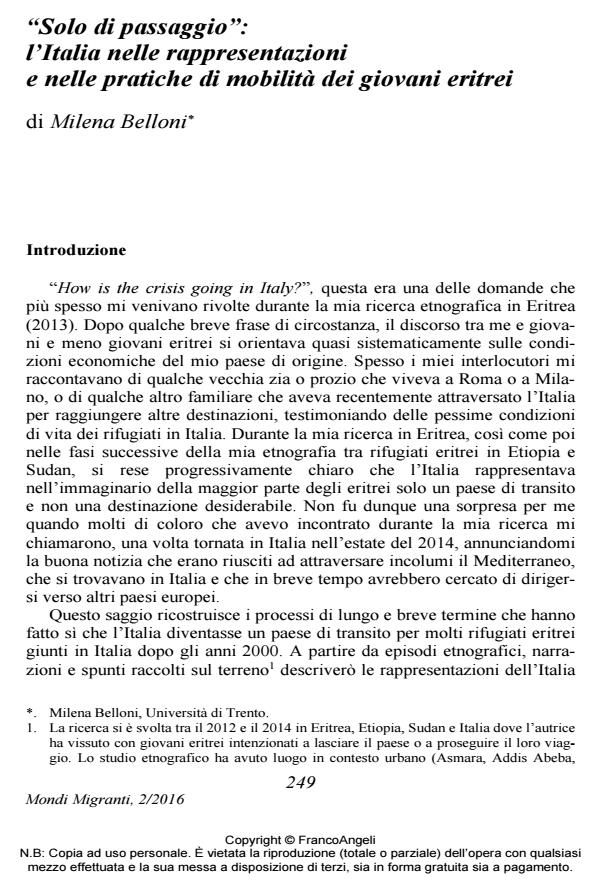"Solo di passaggio": l’Italia nelle rappresentazioni e nelle pratiche di mobilità dei giovani eritrei
Titolo Rivista MONDI MIGRANTI
Autori/Curatori Milena Belloni
Anno di pubblicazione 2016 Fascicolo 2016/2
Lingua Italiano Numero pagine 19 P. 249-267 Dimensione file 193 KB
DOI 10.3280/MM2016-002013
Il DOI è il codice a barre della proprietà intellettuale: per saperne di più
clicca qui
Qui sotto puoi vedere in anteprima la prima pagina di questo articolo.
Se questo articolo ti interessa, lo puoi acquistare (e scaricare in formato pdf) seguendo le facili indicazioni per acquistare il download credit. Acquista Download Credits per scaricare questo Articolo in formato PDF

FrancoAngeli è membro della Publishers International Linking Association, Inc (PILA)associazione indipendente e non profit per facilitare (attraverso i servizi tecnologici implementati da CrossRef.org) l’accesso degli studiosi ai contenuti digitali nelle pubblicazioni professionali e scientifiche
La migrazione eritrea verso l'Europa, di passaggio attraverso l'Italia, è un fenomeno di crescente visibilità, ma relativamente poco studiato e non sempre ben compreso. Basandosi su una ricerca etnografica condotta in Eritrea, in Etiopia ed in Italia tra il 2012 e il 2014, questo articolo ricostruisce i fattori e le dinamiche sociali per cui la maggior parte dei rifugiati eritrei non desidera fermarsi in Italia. Nel dibattito sui movimenti secondari si enfatizzano le condizioni economiche sfavorevoli che spingono i rifugiati a continuare il viaggio, o i legami familiari che facilitano e orientano le traiettorie dei richiedenti asilo, ma raramente si prende in considerazione l'influenza delle rappresentazioni sociali prevalenti sui percorsi migratori. Questo studio mostra che l’Italia ha acquisito, tra i gruppi di eritrei che ancora vivono in madrepatria e quelli che già sono in viaggio, l’immagine di un paese sicuro, ma non favorevole alla realizzazione del progetto migratorio. Questa immagine, in parte, affonda le radici nella storia della migrazione eritrea in Italia e in parte è il risultato dei flussi transnazionali di informazioni mediatiche e individuali che si trasmettono attraverso le reti informali dei migranti eritrei su scala globale.
Parole chiave:Rifugiati eritrei; Italia; migrazione di transito; movimenti secondari; rappresentazioni sociali; destinazioni migratorie.
- Il diritto di restare: il Regolamento Dublino, i volti, le storie e le possibili buone pratiche Ilaria Sommaruga, Annapaola Ammirati, in MONDI MIGRANTI 1/2018 pp.107
DOI: 10.3280/MM2018-001006
Milena Belloni, "Solo di passaggio": l’Italia nelle rappresentazioni e nelle pratiche di mobilità dei giovani eritrei in "MONDI MIGRANTI" 2/2016, pp 249-267, DOI: 10.3280/MM2016-002013